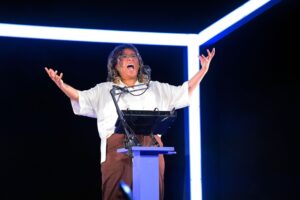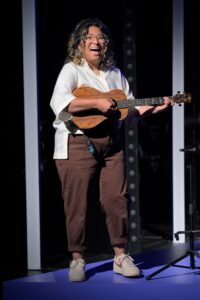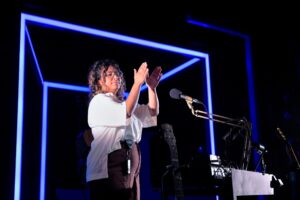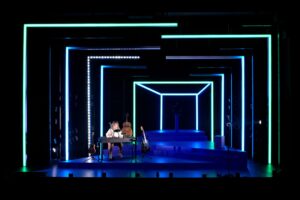Where Did We Sit on the Bus?
Brian Quijada (Book and Music); Satya Chávez (Additional Compositions)
Marin Theatre Company

When he was in the third grade, Brian Quijada sat in a classroom during a lesson about Rosa Parks contemplating the bus where she took her seat. In the front, he heard, was where the whites normally sat; in the back were the Blacks. Brown-skinned, Salvadorean-American Brian raised his hand to ask, “Where did we sit on the bus?” After a very pregnant pause, his flustered teacher answered, “You were not there.”
That answer exasperated Brian enough that once he grew up to become a Latine actor, musician, poet, and playwright, he took that small boy’s question and created Where Did We Sit on the Bus? Employing the sounds of his childhood such as hip hop, Latin rhythms, 70s/80s rock, and R&B, he set out to explore his own life’s story as a means to figure out how he might one day explain to his children a history that he was denied a chance to learn.

After performing the solo piece in a number of theatres and stages, Brian Quijada now turns his story over to a Mexican-American, queer actor (and also composer, musician and director), Satya Chávez, who becomes Bee (instead of Brian) Quijada in Marin Theatre Company’s West Coast premiere of Where Did We Sit on the Bus? Much like the work’s creator, Satya Chávez combines poetry, rap, singing, dance, instrumental playing, and masterful looping – adding compositions of her own to Quijada’s originals – to produce a thrilling, captivating, truly tour-de-force performance that goes a long way answering that third-grader’s question for any and every Latine kid in the U.S. – be they Brian, Bee, or whoever.
Content aside for the moment, Satya Chávez (who goes by masculine, feminine, and third-party pronouns) is a wonder to watch as they move about the multi-level stage among an assortment of instruments and looping equipment. By repeatedly looping recordings of sounds, beats, and/or sung/played notes, they produce on the spot multi-layered harmonies of their own voice that are often accompanied by one or more instruments as well as beatbox percussion created by their mouth, lips, tongue, and/or voice.

Scattered around the stage are guitars of various sizes, a keyboard, flute, and shakers – all of which are used both in recordings or just with a beautifully and hauntingly melodic voice that is also capable of packing much power. The many varieties of music range from soulful, layered-in-harmony chants to hard-knocking, fast-paced rap to a song that could be sung in a basement nightclub at 2 a.m. Intermingled with the music is a story of their life told in small vignettes; acted in the voices and persona of parents, teachers, and other kids; highlighted by poetry; and jazzed up with snippets of salsa, hip-hop, and swing dancing.

The story they tell begins in the womb of their mother, includes birth process and trip home from the hospital, and continues year-by-year until somewhere in the late twenties/early thirties. Remembered sounds like her mother’s hands patting out homemade tortillas or like kids’ mimicking taunts on the playground become recorded backgrounds for a memory shared in more detail.
Asking parents “Where were we?” leads to our hearing from their mouths (through Satya) a father’s and a mother’s separate stories of immigration. A father speaking with a gruff voice with one hand in a pocket and the other slicing air to emphasize each word and a mother constantly flipping her hair while speaking in a voice soft and sweet each tell how they came sneaking illegally across the border and literally risking life and limb to leave a life of extreme poverty to come to a land of promised opportunities.
A young Bee hears early on that Regina and Eduardo came here so Bee can so something important in their life – a doctor, a lawyer, a scientist. However, from the age of four or so, Bee is clear that they want only to make music, to act, to be on stage. With dreams conflicting like those, we also hear along the way how time and again from elementary through high school, the performer Bee had to look out over an audience and see two empty chairs where their parents should have been.
The memories and stories spill forth, some more interesting than others; but none quite able to top what our narrator remembers once hearing as a young kid the meaning of “Quijada.” The young Bee was told by parents that in Spanish their name means “jaw” and that they have that name because the Quijadas have always had “big jaws.” When on the playground Bee is later teased, they create a tall tale that their great-great-great-etc.-grandfather had such a mighty jaw that one day when someone made him mad, he ate that person, then the whole family, and then even the dog. With huge animation, bombastic background sounds, and an energy exploding all over the stage, Bee recreates how they then warned her own playground tormenters that with their inherited jaw, they could also eat up bullies!

Adding greatly to the drama and excitement of Bee’s tales is the setting in which they operate on the Marin stage. Tanya Orellana has designed a half-dozen or so receding openings on several levels that are bordered on the sides and top by neon lights. Pablo Santiago in turn has designed an extremely well-timed, effective use of those layered neons that brighten in many iridescent colors to match the mood, moment, and music of Bee’s current tale or song. The changes occur in such exacting timing to be astounding and even jaw-dropping. Much credit must go also to Director Matt Dickson who has overall orchestrated Bee’s constant shifts in location, their switches in performance mode and manner, and the overall level of energy to help propel a life’s story through so many recalled scenes along with the appropriately expressed emotions and expressions of a child, teen, or young adult.
As the years progress, some of Bee’s story begins to lag a bit and to feel like a lecture one might give in a classroom or at a high school assembly about such things as the true meaning of the Statute of Liberty, for example. To that end, Where Did We Sit on the Bus? is ripe for middle and high school audiences, especially in those districts where there are large groups of brown-skinned kids who might wonder the same thing Brian and Bee did at one point when they learn in class about Rosa Parks. The dynamic, all-engrossing way that Brian Quijada first conceived telling his story and the way that Satya Chávez has added their own flavor and voice to make Brian’s history now Bee’s history is very compelling for any audience; but for kids like Brian and Bee, seeing Where Did We Sit on the Bus? could be life changing.
Rating: 4 E
Where Did We Sit on the Bus? continues through My 28, 2023, in solo performance by Satya Chávez at Marin Theatre Company, 397 Miller Avenue, Mill Valley, CA. Tickets are available online at https://www.marintheatre.org/ or by phone at 415-388-5200.
Please note: All patrons must wear a well-fitting mask in the theatre.
Photo Credits: Kevin Berne
